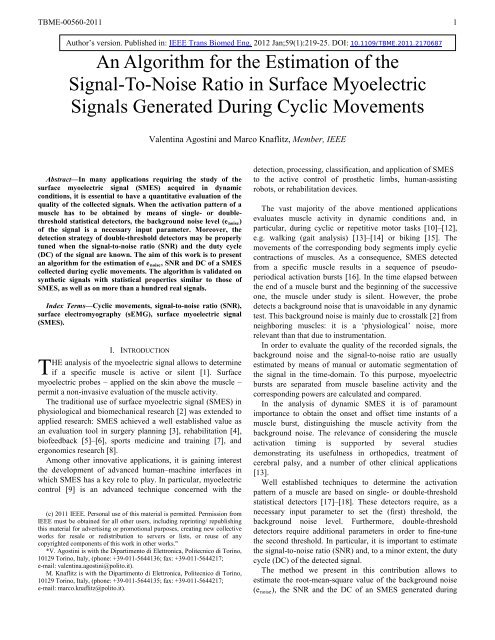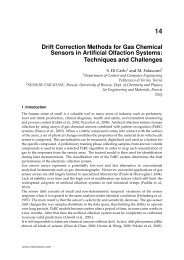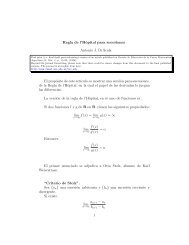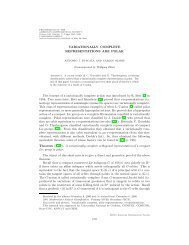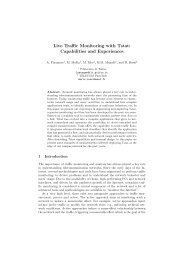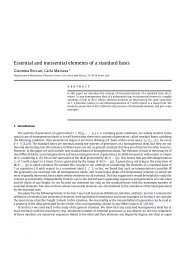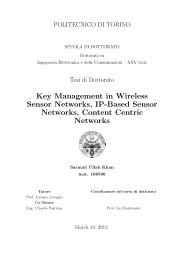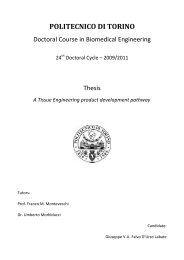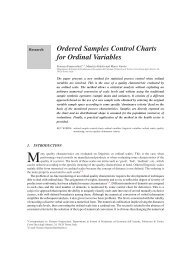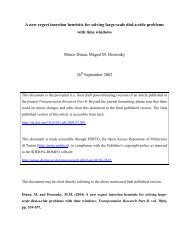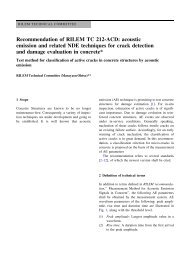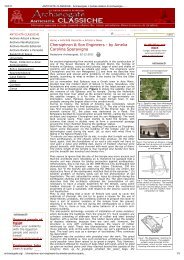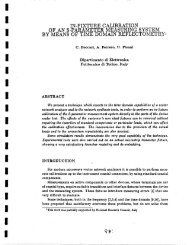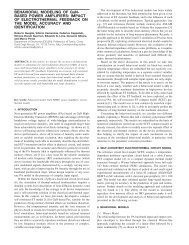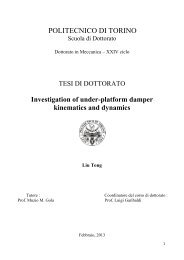An Algorithm for the Estimation of the Signal-To-Noise Ratio in ...
An Algorithm for the Estimation of the Signal-To-Noise Ratio in ...
An Algorithm for the Estimation of the Signal-To-Noise Ratio in ...
Create successful ePaper yourself
Turn your PDF publications into a flip-book with our unique Google optimized e-Paper software.
TBME-00560-2011 1<br />
Author’s version. Published <strong>in</strong>: IEEE Trans Biomed Eng. 2012 Jan;59(1):219-25. DOI: 10.1109/TBME.2011.2170687<br />
<strong>An</strong> <strong>Algorithm</strong> <strong>for</strong> <strong>the</strong> <strong>Estimation</strong> <strong>of</strong> <strong>the</strong><br />
<strong>Signal</strong>-<strong>To</strong>-<strong>Noise</strong> <strong>Ratio</strong> <strong>in</strong> Surface Myoelectric<br />
<strong>Signal</strong>s Generated Dur<strong>in</strong>g Cyclic Movements<br />
Abstract—In many applications requir<strong>in</strong>g <strong>the</strong> study <strong>of</strong> <strong>the</strong><br />
surface myoelectric signal (SMES) acquired <strong>in</strong> dynamic<br />
conditions, it is essential to have a quantitative evaluation <strong>of</strong> <strong>the</strong><br />
quality <strong>of</strong> <strong>the</strong> collected signals. When <strong>the</strong> activation pattern <strong>of</strong> a<br />
muscle has to be obta<strong>in</strong>ed by means <strong>of</strong> s<strong>in</strong>gle- or double-<br />
threshold statistical detectors, <strong>the</strong> background noise level (e<br />
noise)<br />
<strong>of</strong> <strong>the</strong> signal is a necessary <strong>in</strong>put parameter. Moreover, <strong>the</strong><br />
detection strategy <strong>of</strong> double-threshold detectors may be properly<br />
tuned when <strong>the</strong> signal-to-noise ratio (SNR) and <strong>the</strong> duty cycle<br />
(DC) <strong>of</strong> <strong>the</strong> signal are known. The aim <strong>of</strong> this work is to present<br />
an algorithm <strong>for</strong> <strong>the</strong> estimation <strong>of</strong> enoise, SNR and DC <strong>of</strong> a SMES<br />
collected dur<strong>in</strong>g cyclic movements. The algorithm is validated on<br />
syn<strong>the</strong>tic signals with statistical properties similar to those <strong>of</strong><br />
SMES, as well as on more than a hundred real signals.<br />
Index Terms—Cyclic movements, signal-to-noise ratio (SNR),<br />
surface electromyography (sEMG), surface myoelectric signal<br />
(SMES).<br />
I. INTRODUCTION<br />
HE analysis <strong>of</strong> <strong>the</strong> myoelectric signal allows to determ<strong>in</strong>e<br />
T if a specific muscle is active or silent [1]. Surface<br />
myoelectric probes – applied on <strong>the</strong> sk<strong>in</strong> above <strong>the</strong> muscle –<br />
permit a non-<strong>in</strong>vasive evaluation <strong>of</strong> <strong>the</strong> muscle activity.<br />
The traditional use <strong>of</strong> surface myoelectric signal (SMES) <strong>in</strong><br />
physiological and biomechanical research [2] was extended to<br />
applied research: SMES achieved a well established value as<br />
an evaluation tool <strong>in</strong> surgery plann<strong>in</strong>g [3], rehabilitation [4],<br />
bi<strong>of</strong>eedback [5]–[6], sports medic<strong>in</strong>e and tra<strong>in</strong><strong>in</strong>g [7], and<br />
ergonomics research [8].<br />
Among o<strong>the</strong>r <strong>in</strong>novative applications, it is ga<strong>in</strong><strong>in</strong>g <strong>in</strong>terest<br />
<strong>the</strong> development <strong>of</strong> advanced human–mach<strong>in</strong>e <strong>in</strong>terfaces <strong>in</strong><br />
which SMES has a key role to play. In particular, myoelectric<br />
control [9] is an advanced technique concerned with <strong>the</strong><br />
(c) 2011 IEEE. Personal use <strong>of</strong> this material is permitted. Permission from<br />
IEEE must be obta<strong>in</strong>ed <strong>for</strong> all o<strong>the</strong>r users, <strong>in</strong>clud<strong>in</strong>g repr<strong>in</strong>t<strong>in</strong>g/ republish<strong>in</strong>g<br />
this material <strong>for</strong> advertis<strong>in</strong>g or promotional purposes, creat<strong>in</strong>g new collective<br />
works <strong>for</strong> resale or redistribution to servers or lists, or reuse <strong>of</strong> any<br />
copyrighted components <strong>of</strong> this work <strong>in</strong> o<strong>the</strong>r works."<br />
*V. Agost<strong>in</strong>i is with <strong>the</strong> Dipartimento di Elettronica, Politecnico di <strong>To</strong>r<strong>in</strong>o,<br />
10129 <strong>To</strong>r<strong>in</strong>o, Italy, (phone: +39-011-5644136; fax: +39-011-5644217;<br />
e-mail: valent<strong>in</strong>a.agost<strong>in</strong>i@polito.it).<br />
M. Knaflitz is with <strong>the</strong> Dipartimento di Elettronica, Politecnico di <strong>To</strong>r<strong>in</strong>o,<br />
10129 <strong>To</strong>r<strong>in</strong>o, Italy, (phone: +39-011-5644135; fax: +39-011-5644217;<br />
e-mail: marco.knaflitz@polito.it).<br />
Valent<strong>in</strong>a Agost<strong>in</strong>i and Marco Knaflitz, Member, IEEE<br />
detection, process<strong>in</strong>g, classification, and application <strong>of</strong> SMES<br />
to <strong>the</strong> active control <strong>of</strong> pros<strong>the</strong>tic limbs, human-assist<strong>in</strong>g<br />
robots, or rehabilitation devices.<br />
The vast majority <strong>of</strong> <strong>the</strong> above mentioned applications<br />
evaluates muscle activity <strong>in</strong> dynamic conditions and, <strong>in</strong><br />
particular, dur<strong>in</strong>g cyclic or repetitive motor tasks [10]–[12],<br />
e.g. walk<strong>in</strong>g (gait analysis) [13]–[14] or bik<strong>in</strong>g [15]. The<br />
movements <strong>of</strong> <strong>the</strong> correspond<strong>in</strong>g body segments imply cyclic<br />
contractions <strong>of</strong> muscles. As a consequence, SMES detected<br />
from a specific muscle results <strong>in</strong> a sequence <strong>of</strong> pseudoperiodical<br />
activation bursts [16]. In <strong>the</strong> time elapsed between<br />
<strong>the</strong> end <strong>of</strong> a muscle burst and <strong>the</strong> beg<strong>in</strong>n<strong>in</strong>g <strong>of</strong> <strong>the</strong> successive<br />
one, <strong>the</strong> muscle under study is silent. However, <strong>the</strong> probe<br />
detects a background noise that is unavoidable <strong>in</strong> any dynamic<br />
test. This background noise is ma<strong>in</strong>ly due to crosstalk [2] from<br />
neighbor<strong>in</strong>g muscles: it is a ‘physiological’ noise, more<br />
relevant than that due to <strong>in</strong>strumentation.<br />
In order to evaluate <strong>the</strong> quality <strong>of</strong> <strong>the</strong> recorded signals, <strong>the</strong><br />
background noise and <strong>the</strong> signal-to-noise ratio are usually<br />
estimated by means <strong>of</strong> manual or automatic segmentation <strong>of</strong><br />
<strong>the</strong> signal <strong>in</strong> <strong>the</strong> time-doma<strong>in</strong>. <strong>To</strong> this purpose, myoelectric<br />
bursts are separated from muscle basel<strong>in</strong>e activity and <strong>the</strong><br />
correspond<strong>in</strong>g powers are calculated and compared.<br />
In <strong>the</strong> analysis <strong>of</strong> dynamic SMES it is <strong>of</strong> paramount<br />
importance to obta<strong>in</strong> <strong>the</strong> onset and <strong>of</strong>fset time <strong>in</strong>stants <strong>of</strong> a<br />
muscle burst, dist<strong>in</strong>guish<strong>in</strong>g <strong>the</strong> muscle activity from <strong>the</strong><br />
background noise. The relevance <strong>of</strong> consider<strong>in</strong>g <strong>the</strong> muscle<br />
activation tim<strong>in</strong>g is supported by several studies<br />
demonstrat<strong>in</strong>g its usefulness <strong>in</strong> orthopedics, treatment <strong>of</strong><br />
cerebral palsy, and a number <strong>of</strong> o<strong>the</strong>r cl<strong>in</strong>ical applications<br />
[13].<br />
Well established techniques to determ<strong>in</strong>e <strong>the</strong> activation<br />
pattern <strong>of</strong> a muscle are based on s<strong>in</strong>gle- or double-threshold<br />
statistical detectors [17]–[18]. These detectors require, as a<br />
necessary <strong>in</strong>put parameter to set <strong>the</strong> (first) threshold, <strong>the</strong><br />
background noise level. Fur<strong>the</strong>rmore, double-threshold<br />
detectors require additional parameters <strong>in</strong> order to f<strong>in</strong>e-tune<br />
<strong>the</strong> second threshold. In particular, it is important to estimate<br />
<strong>the</strong> signal-to-noise ratio (SNR) and, to a m<strong>in</strong>or extent, <strong>the</strong> duty<br />
cycle (DC) <strong>of</strong> <strong>the</strong> detected signal.<br />
The method we present <strong>in</strong> this contribution allows to<br />
estimate <strong>the</strong> root-mean-square value <strong>of</strong> <strong>the</strong> background noise<br />
), <strong>the</strong> SNR and <strong>the</strong> DC <strong>of</strong> an SMES generated dur<strong>in</strong>g<br />
(enoise
TBME-00560-2011 2<br />
Fig. 1. Cyclo-stationary processes with enoise = 1µV and SNR = 20 dB.<br />
Upper plots: representation <strong>of</strong> a s<strong>in</strong>gle cycle with (a) DC = 20%, (b) DC =<br />
50%, (c) DC = 80%. Lower plots: histograms <strong>of</strong> <strong>the</strong> amplitudes <strong>of</strong> <strong>the</strong> three<br />
processes. The time support <strong>of</strong> <strong>the</strong> signals considered to obta<strong>in</strong> <strong>the</strong><br />
histograms is equal to 30 s.<br />
cyclic movements. This is done follow<strong>in</strong>g a statistical<br />
approach that does not require any a priori knowledge on <strong>the</strong><br />
signal. In this way, we obta<strong>in</strong> <strong>the</strong> <strong>in</strong>put parameters necessary<br />
to run double-threshold algorithms without <strong>the</strong> need <strong>of</strong> preprocess<strong>in</strong>g<br />
<strong>the</strong> signal <strong>in</strong> <strong>the</strong> time doma<strong>in</strong>.<br />
II. MATERIALS AND METHODS<br />
A. The surface myoelectric signal <strong>in</strong> cyclic movements<br />
The SMES recorded dur<strong>in</strong>g cyclic contractions may be<br />
considered as <strong>the</strong> superposition <strong>of</strong> <strong>the</strong> signal generated by <strong>the</strong><br />
observed muscle dur<strong>in</strong>g its contraction and <strong>the</strong> background<br />
noise. This noise is ma<strong>in</strong>ly due to <strong>the</strong> activity <strong>of</strong> neighbor<strong>in</strong>g<br />
muscles, collected because <strong>of</strong> <strong>the</strong> limited spatial selectivity <strong>of</strong><br />
<strong>the</strong> detection probe. Moreover, due to <strong>the</strong> cyclic nature <strong>of</strong> <strong>the</strong><br />
movement, this process may be def<strong>in</strong>ed as cyclostationary<br />
[19]. Its periodicity depends on <strong>the</strong> cyclic movement under<br />
<strong>in</strong>vestigation.<br />
In its period <strong>of</strong> cyclostationarity, <strong>the</strong> signal can be modeled<br />
as <strong>the</strong> superposition <strong>of</strong> two stationary processes: noise only,<br />
when <strong>the</strong> muscle is not active, and a second process<br />
correspond<strong>in</strong>g to <strong>the</strong> muscle activity.<br />
When <strong>the</strong> muscle is non-active (OFF-state) only<br />
background noise is present. This noise can be modeled as a<br />
Gaussian process with zero-mean and variance σ :<br />
2<br />
n(t) ∈ Ν(0,<br />
σ ) . (1)<br />
n<br />
Dur<strong>in</strong>g muscle activity (ON-state), <strong>the</strong> SMES can be<br />
modeled as a zero-mean Gaussian process given by <strong>the</strong><br />
superimposition <strong>of</strong> two Gaussian processes correspond<strong>in</strong>g to<br />
signal and background noise, respectively:<br />
2<br />
n<br />
2 2<br />
x(t) = s(t) + n(t) ∈ Ν(0,<br />
σ + σ ) , (2)<br />
be<strong>in</strong>g<br />
2<br />
σ s <strong>the</strong> variance <strong>of</strong> s(t).<br />
s<br />
The percentage <strong>of</strong> time <strong>in</strong> which <strong>the</strong> muscle is active with<br />
respect to <strong>the</strong> total cycle duration is referred to as duty cycle.<br />
In <strong>the</strong> follow<strong>in</strong>g, it is assumed that <strong>the</strong> signal x(t) is sampled<br />
with a sampl<strong>in</strong>g period Ts that satisfies <strong>the</strong> Nyquist criterion.<br />
In particular, s<strong>in</strong>ce SMES collected by means <strong>of</strong> usual surface<br />
probes typically has more than 99% <strong>of</strong> <strong>the</strong> signal power below<br />
500 Hz, we consider a sampl<strong>in</strong>g frequency fc = 2 kHz, that<br />
results <strong>in</strong> a two-time oversampl<strong>in</strong>g.<br />
B. Separat<strong>in</strong>g signal from noise<br />
The probability density function <strong>of</strong> <strong>the</strong> cyclostationary<br />
signal considered above is given by <strong>the</strong> superposition <strong>of</strong> <strong>the</strong><br />
probability density functions correspond<strong>in</strong>g to x(t) and n(t)<br />
and depends also on <strong>the</strong> DC. As an example, Fig. 1 reports<br />
<strong>the</strong> histograms <strong>of</strong> three cyclostationary processes<br />
correspond<strong>in</strong>g to enoise equal to 1 µV, SNR equal to 20 dB and<br />
DC equal to 20%, 50% and 80%, respectively.<br />
The separation <strong>of</strong> <strong>the</strong> ON-state from <strong>the</strong> OFF-state could be<br />
obta<strong>in</strong>ed by apply<strong>in</strong>g a proper detector, but such detectors<br />
would require, as an <strong>in</strong>put parameter, <strong>the</strong> root-mean-square<br />
value <strong>of</strong> <strong>the</strong> background noise enoise<br />
[18], that is unknown. A<br />
possible solution <strong>for</strong> estimat<strong>in</strong>g enoise, without actually<br />
separat<strong>in</strong>g <strong>the</strong> ON and OFF states <strong>in</strong> <strong>the</strong> time doma<strong>in</strong>, consists<br />
<strong>of</strong> consider<strong>in</strong>g an auxiliary time series with a χ 2<br />
distribution.<br />
The amplitude histogram <strong>of</strong> <strong>the</strong> auxiliary time series has two<br />
separated modes, one correspond<strong>in</strong>g to <strong>the</strong> noise variance and<br />
<strong>the</strong> o<strong>the</strong>r to <strong>the</strong> signal variance.<br />
The auxiliary time series Cr(k)<br />
is obta<strong>in</strong>ed subdivid<strong>in</strong>g <strong>the</strong><br />
time series x(t) <strong>in</strong> M epochs constituted by r consecutive<br />
samples and <strong>the</strong>n consider<strong>in</strong>g <strong>the</strong> normalized sum <strong>of</strong> squares<br />
<strong>of</strong> each epoch:<br />
X kj<br />
Cr<br />
(k) = , k = 1,…,M . (3)<br />
r<br />
r<br />
∑<br />
j=<br />
1<br />
2<br />
Fig. 2. Histograms <strong>of</strong> <strong>the</strong> series <strong>of</strong> <strong>the</strong> normalized sum <strong>of</strong> squares Cr (<strong>in</strong><br />
logarithmic scale) <strong>of</strong> a 30s-cyclostationary process with SNR = 20 dB and<br />
DC = 50% <strong>for</strong> (a) r = 2, (b) r = 10, (c) r = 50.<br />
n
TBME-00560-2011 3<br />
Fig. 3. Histogram <strong>of</strong> Log10C relative to a cyclic signal with enoise = 1µV,<br />
SNR = 20 dB and DC = 50% (time support <strong>of</strong> <strong>the</strong> signal = 30 s). The darkcolored<br />
bars <strong>in</strong>dicate <strong>the</strong> b<strong>in</strong>s used by <strong>the</strong> algorithm to estimate <strong>the</strong><br />
parameters.<br />
If <strong>the</strong> signal follows <strong>the</strong> hypo<strong>the</strong>sized model, <strong>the</strong> time series<br />
has a bimodal distribution with two separated modes. The<br />
2 2<br />
larger is <strong>the</strong> difference among σ n and σ s , <strong>the</strong> greater is <strong>the</strong><br />
distance between <strong>the</strong> modes.<br />
As an example, Fig. 2 reports <strong>the</strong> bimodal distributions<br />
obta<strong>in</strong>ed <strong>for</strong> r = 2, r = 10 and r = 50, respectively. It is evident<br />
that <strong>in</strong>creas<strong>in</strong>g r allows <strong>for</strong> a better separation <strong>of</strong> <strong>the</strong> two<br />
modes, but contemporarily, due to <strong>the</strong> reduced size <strong>of</strong> <strong>the</strong><br />
series Cr(k),<br />
we have a reduced number <strong>of</strong> samples. Moreover,<br />
<strong>in</strong>creas<strong>in</strong>g <strong>the</strong> r value causes a loss <strong>of</strong> time resolution from 1<br />
ms (r = 2) up to 25 ms (r = 50). A satisfactory trade<strong>of</strong>f may be<br />
obta<strong>in</strong>ed by choos<strong>in</strong>g r = 10 (time resolution equal to 5 ms).<br />
This guarantees an acceptable time resolution, a good<br />
separation between <strong>the</strong> noise and <strong>the</strong> signal modes, and a<br />
sufficient number <strong>of</strong> samples to build <strong>the</strong> histogram.<br />
The assumption <strong>of</strong> gaussianity <strong>of</strong> <strong>the</strong> SMES allows to treat<br />
<strong>the</strong> auxiliary time series Cr(k)<br />
as χ 2 -distributed. This is useful<br />
to determ<strong>in</strong>e <strong>the</strong> number <strong>of</strong> consecutive samples (r) that<br />
constitute Cr(k)<br />
<strong>in</strong> an optimal way. However, even if <strong>the</strong><br />
SMES is not exactly Gaussian, <strong>the</strong> auxiliary time series will<br />
still be two-bell shaped and <strong>the</strong> algorithm described below will<br />
give reliable results.<br />
C. Description <strong>of</strong> <strong>the</strong> algorithm<br />
In order to estimate enoise,<br />
SNR and DC <strong>of</strong> an SMES<br />
generated dur<strong>in</strong>g cyclic movements we use <strong>the</strong> follow<strong>in</strong>g<br />
algorithm:<br />
1) Consider <strong>the</strong> time series {xi},<br />
i = 1,…, N, be<strong>in</strong>g N <strong>the</strong><br />
number <strong>of</strong> samples. In <strong>the</strong> follow<strong>in</strong>g, we refer to a time series<br />
with a duration equal to 30 s sampled at sampl<strong>in</strong>g frequency<br />
equal to 2 kHz. It follows that <strong>the</strong> number <strong>of</strong> samples N is<br />
equal to 60000.<br />
2) Divide {xi}<br />
<strong>in</strong>to M = N/r epochs. Consider<strong>in</strong>g r = 10 we<br />
have:<br />
Fig. 4. Histogram <strong>of</strong> Log10C relative to a cyclic signal with enoise = 1µV,<br />
SNR = 6 dB and DC = 50% (time support <strong>of</strong> <strong>the</strong> signal = 30 s). The darkcolored<br />
bars <strong>in</strong>dicate <strong>the</strong> b<strong>in</strong>s used by <strong>the</strong> algorithm to estimate <strong>the</strong><br />
parameters.<br />
{X kj}<br />
= {X1j,<br />
X 2j,<br />
…,<br />
X Mj},<br />
j = 1, …,10<br />
3) Obta<strong>in</strong> <strong>the</strong> auxiliary time series <strong>of</strong> <strong>the</strong> normalized sum <strong>of</strong><br />
squares:<br />
10 2<br />
X kj<br />
C (k) = ∑ , k = 1, …,<br />
M .<br />
(4)<br />
j=<br />
1 10<br />
4) Obta<strong>in</strong> <strong>the</strong> histogram <strong>of</strong> <strong>the</strong> series Log10 C. The b<strong>in</strong>s <strong>of</strong><br />
<strong>the</strong> histogram are def<strong>in</strong>ed as:<br />
max( Log10C)<br />
− m<strong>in</strong>( Log10C)<br />
b<strong>in</strong>s(m) ≡ m ⋅<br />
2 ⋅ Nb<strong>in</strong>s<br />
(5)<br />
+ m<strong>in</strong>( Log C),<br />
m = 1,<br />
3,...,<br />
2 ⋅ Nb<strong>in</strong>s −1.<br />
10<br />
where Nb<strong>in</strong>s is <strong>the</strong> number <strong>of</strong> b<strong>in</strong>s. S<strong>in</strong>ce <strong>in</strong> our case M =<br />
6000, to have a sufficient sample numerosity <strong>for</strong> each b<strong>in</strong> we<br />
choose Nb<strong>in</strong>s = 60. In general, a number <strong>of</strong> b<strong>in</strong>s <strong>in</strong> <strong>the</strong> range<br />
50-100 is an acceptable choice.<br />
5) Search <strong>for</strong> local maxima <strong>of</strong> <strong>the</strong> curve that <strong>in</strong>terpolates <strong>the</strong><br />
frequencies <strong>of</strong> <strong>the</strong> histogram. Locate <strong>the</strong> absolute maximum<br />
and <strong>the</strong> highest relative maximum. The leftmost po<strong>in</strong>t <strong>of</strong><br />
maximum is associated to noise (Inoise), <strong>the</strong> rightmost is<br />
associated to signal (Isignal).<br />
6) Estimate <strong>the</strong> mean power <strong>of</strong> <strong>the</strong> noise, averag<strong>in</strong>g five<br />
b<strong>in</strong>s around I :<br />
I<br />
+ 2<br />
noise<br />
∑<br />
noise<br />
i = Inoise<br />
−2<br />
noise = Inoise<br />
+ 2<br />
P<br />
b<strong>in</strong>s(i) ⋅ Freq(i)<br />
. (6)<br />
∑<br />
i = Inoise<br />
−2<br />
Freq(i)<br />
7) Estimate <strong>the</strong> mean power <strong>of</strong> <strong>the</strong> signal, averag<strong>in</strong>g five<br />
b<strong>in</strong>s around Isignal:
TBME-00560-2011 4<br />
Fig. 5. Representation <strong>of</strong> 1 cycle <strong>of</strong> <strong>the</strong> syn<strong>the</strong>tic SMES obta<strong>in</strong>ed with (a) a<br />
rectangular w<strong>in</strong>dow, (b) a Gaussian w<strong>in</strong>dow with σ=1 and (c) a Gaussian<br />
w<strong>in</strong>dow with σ=2. In this example SNR = 20 dB and DC = 50%.<br />
Isignal+<br />
2<br />
∑<br />
i = Isignal−2<br />
signal = Isignal+<br />
2<br />
P<br />
b<strong>in</strong>s(i) ⋅ Freq(i)<br />
. (7)<br />
∑<br />
i = Isignal−2<br />
Freq(i)<br />
8) Estimate <strong>the</strong> root-mean-square value <strong>of</strong> <strong>the</strong> background<br />
noise enoise:<br />
e = P . (8)<br />
noise<br />
noise<br />
TABLE I<br />
RECTANGULAR WINDOW<br />
enoise (µV)<br />
20% 40% 60% 80%<br />
6 dB 1.00 ± 0.01 1.00 ± 0.04 1.02 ± 0.03 1.52 ± 0.63<br />
12 dB 1.00 ± 0.01 1.01 ± 0.03 1.00 ± 0.02 1.01 ± 0.04<br />
18 dB 1.00 ± 0.02 1.00 ± 0.02 1.00 ± 0.02 1.00 ± 0.02<br />
24 dB 1.01 ± 0.02 1.00 ± 0.02 1.00 ± 0.02 0.99 ± 0.01<br />
30 dB 0.99 ± 0.02 1.00 ± 0.02 1.00 ± 0.02 1.00 ± 0.03<br />
SNR (dB)<br />
20% 40% 60% 80%<br />
6 dB 5.9 ± 0.3 5.9 ± 0.5 5.7 ± 0.4 3.4 ± 3.0<br />
12 dB 12.0 ± 0.4 11.9 ± 0.4 11.9 ± 0.2 11.9 ± 0.3<br />
18 dB 17.9 ± 0.3 18.1 ± 0.2 17.8 ± 0.2 18.0 ± 0.3<br />
24 dB 23.9 ± 0.2 24.0 ± 0.2 23.9 ± 0.2 24.2 ± 0.2<br />
30 dB 30.0 ± 0.2 30.0 ± 0.2 30.0 ± 0.2 30.0 ± 0.2<br />
DC (%)<br />
20% 40% 60% 80%<br />
6 dB 20.1 ± 0.7 39.6 ± 0.6 59.1 ± 0.6 80.5 ± 6.9<br />
12 dB 19.8 ± 1.0 39.9 ± 0.7 60.2 ± 0.6 80.4 ± 0.6<br />
18 dB 20.2 ± 0.5 40.1 ± 0.6 60.3 ± 0.6 80.3 ± 0.5<br />
24 dB 20.2 ± 0.6 40.4 ± 0.6 60.1 ± 0.7 80.6 ± 0.6<br />
30 dB 20.1 ± 0.4 40.2 ± 0.5 60.4 ± 0.6 80.4 ± 0.3<br />
<strong>Estimation</strong> <strong>of</strong> background noise (enoise), signal-to-noise ratio (SNR) and<br />
duty cycle (DC) <strong>for</strong> syn<strong>the</strong>tic signals obta<strong>in</strong>ed with a rectangular w<strong>in</strong>dow.<br />
It is reported <strong>the</strong> mean value estimated over ten realizations ± its standard<br />
deviation.<br />
9) Estimate <strong>the</strong> SNR (<strong>in</strong> dB):<br />
SNR<br />
DC<br />
P<br />
− P<br />
signal noise<br />
= 10 ⋅ Log<br />
. (9)<br />
10<br />
Pnoise<br />
10) Estimate <strong>the</strong> duty cycle (%):<br />
100<br />
= ⋅ Isignal+<br />
2<br />
∑<br />
noise<br />
∑ Freq(i) + ∑<br />
i = Isignal−2<br />
Isignal+<br />
2<br />
i = Isignal−2<br />
Freq(i)<br />
TABLE II<br />
GAUSSIAN WINDOW WITH σ = 1<br />
enoise (µV)<br />
20% 40% 60% 80%<br />
6 dB 0.99 ± 0.03 1.01 ± 0.02 1.17 ± 0.31 1.60 ± 0.47<br />
12 dB 1.00 ± 0.02 1.00 ± 0.02 0.99 ± 0.03 1.00 ± 0.04<br />
18 dB 1.00 ± 0.02 1.00 ± 0.02 1.00 ± 0.02 1.00 ± 0.03<br />
24 dB 1.00 ± 0.02 1.00 ± 0.02 1.00 ± 0.02 1.00 ± 0.03<br />
30 dB 1.00 ± 0.02 0.99 ± 0.02 0.99 ± 0.03 1.00 ± 0.02<br />
SNR (dB)<br />
20% 40% 60% 80%<br />
6 dB 4.5 ± 0.5 4.3 ± 0.6 3.8 ± 1.5 4.1 ± 2.2<br />
12 dB 10.6 ± 0.4 10.6 ± 0.3 10.5 ± 0.5 10.5 ± 0.5<br />
18 dB 16.6 ± 0.4 16.6 ± 0.4 16.5 ± 0.2 16.6 ± 0.5<br />
24 dB 22.5 ± 0.3 22.6 ± 0.3 22.6 ± 0.2 22.6 ± 0.4<br />
30 dB 28.5 ± 0.3 28.6 ± 0.4 28.7 ± 0.2 28.7 ± 0.2<br />
DC (%)<br />
20% 40% 60% 80%<br />
6 dB 18.7 ± 0.7 37.8 ± 5.0 55.1 ± 0.8 71.8 ± 1.5<br />
12 dB 17.7 ± 0.8 36.5 ± 0.5 56.4 ± 0.3 77.7 ± 0.7<br />
18 dB 17.7 ± 0.5 36.1 ± 1.0 56.0 ± 0.7 77.8 ± 0.5<br />
24 dB 17.6 ± 0.3 36.2 ± 0.5 56.1 ± 0.4 77.7 ± 0.4<br />
30 dB 17.8 ± 0.4 36.6 ± 0.6 56.8 ± 0.6 77.7 ± 0.6<br />
I<br />
<strong>Estimation</strong> <strong>of</strong> background noise (enoise), signal-to-noise ratio (SNR) and<br />
duty cycle (DC) <strong>for</strong> syn<strong>the</strong>tic signals obta<strong>in</strong>ed with a Gaussian w<strong>in</strong>dow<br />
with σ=1. It is reported <strong>the</strong> mean value estimated over ten realizations ±<br />
its standard deviation.<br />
+ 2<br />
i = Inoise<br />
−2<br />
Freq(i)<br />
. (10)<br />
In order to clarify how <strong>the</strong> algorithm works, Fig. 3<br />
represents a 30s-cyclostationary signal with DC = 50% and<br />
SNR = 20 dB. Fig. 4 reports a similar example with SNR = 6<br />
dB. As one could have expected, <strong>in</strong> <strong>the</strong> 6dB-case <strong>the</strong>re is a<br />
partial superposition between <strong>the</strong> bell-shaped curve relative to<br />
<strong>the</strong> noise and that relative to <strong>the</strong> signal. However, <strong>the</strong>ir modes<br />
are still clearly dist<strong>in</strong>guishable.<br />
III. RESULTS AND DISCUSSION<br />
A. Validation <strong>of</strong> <strong>the</strong> algorithm<br />
Syn<strong>the</strong>tic signals are generated with a time duration <strong>of</strong> 30 s.<br />
They are cyclic with a cycle duration <strong>of</strong> 1 s. They are obta<strong>in</strong>ed<br />
add<strong>in</strong>g a random process simulat<strong>in</strong>g <strong>the</strong> background noise to a<br />
process simulat<strong>in</strong>g <strong>the</strong> SMES generated dur<strong>in</strong>g a muscle
TBME-00560-2011 5<br />
contraction. Background noise is simulated as a Gaussian<br />
process with zero mean and standard deviation equal to 1µV.<br />
The SMES burst is generated as a Gaussian process with zero<br />
mean and standard deviation equal to 10 (SNR/20)<br />
∙1µV,<br />
w<strong>in</strong>dowed on a time support def<strong>in</strong>ed by DC. In order to<br />
simulate different muscle activation modalities we consider<br />
three different types <strong>of</strong> w<strong>in</strong>dows: a) a rectangular w<strong>in</strong>dow,<br />
b) a Gaussian w<strong>in</strong>dow with σ=1, c) a Gaussian w<strong>in</strong>dow with<br />
σ=2 (see Fig. 5).<br />
The per<strong>for</strong>mances <strong>of</strong> <strong>the</strong> algorithm were verified <strong>for</strong> five<br />
different values <strong>of</strong> <strong>the</strong> SNR (6, 12, 18, 24, 30 dB) and <strong>for</strong> four<br />
different values <strong>of</strong> DC (20, 40, 60, 80 %).<br />
TABLE III<br />
GAUSSIAN WINDOW WITH σ = 2<br />
enoise (µV)<br />
20% 40% 60% 80%<br />
6 dB 1.02 ± 0.03 1.05 ± 0.03 1.08 ± 0.04 1.14 ± 0.12<br />
12 dB 1.01 ± 0.02 1.02 ± 0.01 1.05 ± 0.03 1.20 ± 0.33<br />
18 dB 0.99 ± 0.02 1.00 ± 0.02 1.02 ± 0.02 1.49 ± 1.04<br />
24 dB 1.00 ± 0.02 1.00 ± 0.02 1.00 ± 0.03 1.36 ± 1.36<br />
30 dB 1.00 ± 0.02 0.99 ± 0.02 0.99 ± 0.03 1.44 ± 2.19<br />
SNR (dB)<br />
20% 40% 60% 80%<br />
6 dB 4.5 ± 2.5 3.9 ± 2.0 1.2 ± 2.1 0.3 ± 2.1<br />
12 dB 9.2 ± 1.0 9.6 ± 0.6 9.6 ± 0.8 8.2 ± 2.5<br />
18 dB 16.6 ± 0.5 16.3 ± 0.9 16.2 ± 0.5 13.7 ± 4.9<br />
24 dB 21.7 ± 1.0 22.1 ± 0.3 22.4 ± 0.4 21.1 ± 4.5<br />
30 dB 28.2 ± 0.5 28.3 ± 0.5 28.4 ± 0.3 27.4 ± 4.5<br />
DC (%)<br />
20% 40% 60% 80%<br />
6 dB 10.5 ± 1.6 20.9 ± 1.3 36.4 ± 8.1 46.7 ± 9.7<br />
12 dB 10.0 ± 0.4 22.0 ± 0.8 35.6 ± 0.9 50.6 ± 1.2<br />
18 dB 10.0 ± 0.4 22.2 ± 0.8 39.2 ± 0.8 61.3 ± 2.0<br />
24 dB 10.1 ± 0.8 22.9 ± 0.6 39.9 ± 0.9 64.1 ± 1.1<br />
30 dB 10.4 ± 0.4 23.3 ± 0.5 40.8 ± 0.7 64.8 ± 0.8<br />
<strong>Estimation</strong> <strong>of</strong> background noise (enoise), signal-to-noise ratio (SNR) and<br />
duty cycle (DC) <strong>for</strong> syn<strong>the</strong>tic signals obta<strong>in</strong>ed with a Gaussian w<strong>in</strong>dow<br />
with σ=2. It is reported <strong>the</strong> mean value estimated over ten realizations ±<br />
its standard deviation.<br />
We considered 10 realizations <strong>of</strong> <strong>the</strong> described syn<strong>the</strong>tic<br />
signals and estimated enoise,<br />
SNR and DC <strong>for</strong> each <strong>of</strong> <strong>the</strong>m.<br />
Then, we calculated <strong>the</strong> mean value and standard deviation <strong>of</strong><br />
<strong>the</strong>se parameters over <strong>the</strong> 10 realizations. Table 1 reports <strong>the</strong><br />
results relative to <strong>the</strong> rectangular w<strong>in</strong>dow, Table 2 those<br />
obta<strong>in</strong>ed us<strong>in</strong>g <strong>the</strong> Gaussian w<strong>in</strong>dow with σ = 1, and Table 3<br />
those relative to <strong>the</strong> Gaussian w<strong>in</strong>dow with σ = 2.<br />
The estimated background noise (enoise)<br />
shows values that<br />
are almost always very close to <strong>the</strong> expected value <strong>of</strong> 1µV. In<br />
<strong>the</strong> large majority <strong>of</strong> cases, <strong>the</strong> correspond<strong>in</strong>g error is lower<br />
than 1%. In <strong>the</strong> rectangular w<strong>in</strong>dow case (Table 1) <strong>the</strong><br />
estimated SNR and DC show values that are very close to <strong>the</strong>ir<br />
expected values. Aga<strong>in</strong>, <strong>in</strong> <strong>the</strong> large majority <strong>of</strong> simulation<br />
conditions, <strong>the</strong> error is lower than 1%. In <strong>the</strong> case <strong>of</strong> <strong>the</strong><br />
Gaussian w<strong>in</strong>dow with σ=1, <strong>the</strong>re is a slight underestimation<br />
<strong>of</strong> SNR and DC (see Table 2). This behavior is re<strong>in</strong><strong>for</strong>ced <strong>in</strong><br />
<strong>the</strong> case <strong>of</strong> <strong>the</strong> Gaussian w<strong>in</strong>dow with σ=2. In fact, <strong>the</strong><br />
estimated values are systematically and appreciably lower than<br />
<strong>the</strong> expected ones. This is not surpris<strong>in</strong>g and it is due to <strong>the</strong><br />
shape <strong>of</strong> <strong>the</strong> applied w<strong>in</strong>dow. When deal<strong>in</strong>g with real signals<br />
similar to this typology, <strong>the</strong> estimated values <strong>of</strong> SNR and DC<br />
are always underestimated.<br />
On <strong>the</strong> contrary, when <strong>the</strong> Gaussian w<strong>in</strong>dows are<br />
considered and DC is equal to 80% , <strong>the</strong> estimated value <strong>of</strong> <strong>the</strong><br />
background noise is overestimated up to 60% relative to its<br />
true value. The effect <strong>of</strong> this overestimation is a slight<br />
reduction <strong>of</strong> <strong>the</strong> sensitivity <strong>of</strong> <strong>the</strong> s<strong>in</strong>gle- or double-threshold<br />
detectors, that generally does not compromise <strong>the</strong>ir<br />
per<strong>for</strong>mances.<br />
Although <strong>the</strong> method here<strong>in</strong> presented was developed to<br />
allow <strong>the</strong> tun<strong>in</strong>g <strong>of</strong> statistical detectors, o<strong>the</strong>r applications are<br />
possible. As an example, <strong>the</strong> availability <strong>of</strong> <strong>the</strong> estimates <strong>of</strong><br />
enoise<br />
and SNR makes it possible to evaluate <strong>the</strong> quality <strong>of</strong> <strong>the</strong><br />
acquired signal <strong>in</strong> a user <strong>in</strong>dependent way. This is <strong>of</strong><br />
paramount importance to allow <strong>for</strong> a prompt detection <strong>of</strong><br />
signals whose quality is not high enough to guarantee reliable<br />
results <strong>of</strong> <strong>the</strong> process<strong>in</strong>g techniques applied to <strong>the</strong>m.<br />
B. Test <strong>of</strong> <strong>the</strong> algorithm on real SMES<br />
Although <strong>the</strong> validation <strong>of</strong> <strong>the</strong> proposed algorithm was<br />
carried out work<strong>in</strong>g with syn<strong>the</strong>tic SMES, we tested <strong>the</strong><br />
algorithm also on real signals.<br />
In order to test <strong>the</strong> applicability <strong>of</strong> <strong>the</strong> algorithm to real<br />
SMES, recorded dur<strong>in</strong>g cyclic human movements, we<br />
consider - as an example - signals acquired dur<strong>in</strong>g gait. Our<br />
database consists <strong>of</strong> a total <strong>of</strong> 142 SMES collected from:<br />
Fig. 6. Examples <strong>of</strong> application <strong>of</strong> <strong>the</strong> algorithm to real signals. (a) SMES<br />
from tibialis anterior: enoise1 = 3.2 µV, SNR1 = 28.0 dB, DC1 = 37.8%. (b)<br />
SMES from gastrocnemius lateralis: enoise1 = 1.5 µV, SNR1 = 11.3 dB,<br />
DC1 = 44.6%.
TBME-00560-2011 6<br />
Fig. 7. SMES segmentation <strong>in</strong> <strong>the</strong> time doma<strong>in</strong>. The segments labeled as A1,<br />
A2, … correspond to muscle activations (= ON states), while B1, B2,…<br />
<strong>in</strong>dicate background noise (= OFF states).<br />
tibialis anterior (48), gastrocnemius lateralis (32), lateral<br />
hamstr<strong>in</strong>gs (24), vastus lateralis (24), rectus femoris (14), The<br />
SMES acquisitions were carried out position<strong>in</strong>g surface<br />
myoelectric probes (STEP32, DemItalia, Italy) over <strong>the</strong><br />
muscle’s belly [1]. As <strong>for</strong> <strong>the</strong> syn<strong>the</strong>tic signals, we considered<br />
a time support <strong>of</strong> 30 s. The real signals are “pseudo-cyclic”<br />
with a cycle duration equal to <strong>the</strong> subject gait cycle.<br />
Fig. 6 shows an example <strong>of</strong> SMES collected from (a)<br />
tibialis anterior and (b) gastrocnemius lateralis. The<br />
correspond<strong>in</strong>g two-bell shaped histograms are shown aside.<br />
We estimated <strong>the</strong> parameters both with <strong>the</strong> algorithm<br />
described above and by means <strong>of</strong> an alternative method. The<br />
parameters estimated through <strong>the</strong> proposed algorithm will be<br />
<strong>in</strong>dicated as enoise1, SNR1, DC1, while those estimated with<br />
<strong>the</strong> alternative procedure will be <strong>in</strong>dicated as enoise2, SNR2,<br />
DC2. The alternative procedure consists <strong>of</strong> segment<strong>in</strong>g <strong>the</strong><br />
30-s signals <strong>in</strong> <strong>the</strong> time doma<strong>in</strong>, obta<strong>in</strong><strong>in</strong>g <strong>the</strong> ON and OFF<br />
states by means <strong>of</strong> <strong>the</strong> double-threshold detector [18]. <strong>An</strong><br />
example <strong>of</strong> signal segmentation is shown <strong>in</strong> Fig. 7.<br />
Indicat<strong>in</strong>g with N <strong>the</strong> number <strong>of</strong> segmented gait cycles we<br />
def<strong>in</strong>e:<br />
N<br />
1<br />
e noise2 ≡ ∑ σ Bi ,<br />
(11)<br />
N i = 1<br />
where σ Bi is <strong>the</strong> standard deviation <strong>of</strong> <strong>the</strong> i-th background<br />
noise segment (see Fig. 7).<br />
Fur<strong>the</strong>rmore, we def<strong>in</strong>e:<br />
2<br />
A<br />
NR2 10 log 10 1 ,<br />
2 ⎟<br />
B<br />
⎟<br />
⎛ σ ⎞<br />
S ≡ ⋅ ⎜<br />
−<br />
(12)<br />
⎝ σ ⎠<br />
2<br />
A<br />
2<br />
σ B are <strong>the</strong> mean variances <strong>of</strong> <strong>the</strong> ON and OFF<br />
where σ and<br />
states, respectively.<br />
F<strong>in</strong>ally, we def<strong>in</strong>e:<br />
N<br />
1 Ai<br />
D C2 ≡ ∑ ⋅ 100.<br />
(13)<br />
N i = 1 Ai<br />
+ Bi<br />
Fig. 8 shows <strong>the</strong> comparison <strong>of</strong> <strong>the</strong> two methods on <strong>the</strong> set<br />
<strong>of</strong> 142 real signals. This figure displays, <strong>for</strong> each parameter,<br />
<strong>the</strong> scatter plot <strong>of</strong> <strong>the</strong> values obta<strong>in</strong>ed with <strong>the</strong> proposed<br />
algorithm (x-axis) and with <strong>the</strong> alternative method (y-axis). <strong>To</strong><br />
determ<strong>in</strong>e how well <strong>the</strong> proposed algorithm retrieves <strong>the</strong><br />
values obta<strong>in</strong>ed with <strong>the</strong> “direct” time-doma<strong>in</strong> method we<br />
calculated <strong>the</strong> regression l<strong>in</strong>e among <strong>the</strong> po<strong>in</strong>ts. The l<strong>in</strong>e<br />
among enoise1-enoise2 po<strong>in</strong>ts has a slope close to 1 (0.97)<br />
and a very small y-<strong>in</strong>tercept (0.41 µV rms), demonstrat<strong>in</strong>g <strong>the</strong><br />
accuracy <strong>of</strong> <strong>the</strong> proposed algorithm <strong>in</strong> <strong>the</strong> estimation <strong>of</strong><br />
background noise. Results are still acceptable when<br />
consider<strong>in</strong>g <strong>the</strong> SNR1-SNR2 scatter plot, also if it can be<br />
noticed a slight underestimation <strong>of</strong> SNR1 with respect to<br />
SNR2. For what concerns <strong>the</strong> duty cycle <strong>the</strong> values obta<strong>in</strong>ed<br />
with <strong>the</strong> algorithm are systematically lower than those<br />
obta<strong>in</strong>ed with <strong>the</strong> alternative method <strong>of</strong> about 20% <strong>of</strong> <strong>the</strong> gait<br />
cycle. These f<strong>in</strong>d<strong>in</strong>gs are similar to those already commented<br />
<strong>for</strong> <strong>the</strong> syn<strong>the</strong>tic signals with Gaussian w<strong>in</strong>dow with σ=1 and,<br />
more markedly, <strong>in</strong> <strong>the</strong> case σ=2.<br />
IV. CONCLUSION<br />
This work presents an algorithm <strong>for</strong> <strong>the</strong> estimation <strong>of</strong><br />
background noise, signal-to-noise ratio and duty cycle <strong>of</strong><br />
SMES generated dur<strong>in</strong>g cyclic movements. The algorithm was<br />
tested on syn<strong>the</strong>tic and real SMES and <strong>the</strong> obta<strong>in</strong>ed results<br />
show that, <strong>in</strong> most practical situations, it provides accurate and<br />
stable measures <strong>of</strong> <strong>the</strong> a<strong>for</strong>ementioned parameters.<br />
We adopted this method to choose <strong>the</strong> parameters <strong>of</strong> a<br />
double-threshold statistical detector we previously developed<br />
[18] and that we have been us<strong>in</strong>g <strong>in</strong> <strong>the</strong> past years to carry-out<br />
a user <strong>in</strong>dependent analysis <strong>of</strong> <strong>the</strong> SMES detected dur<strong>in</strong>g<br />
walk. Results we obta<strong>in</strong>ed <strong>in</strong> that field are fully satisfactory<br />
and we believe that <strong>the</strong> approach here<strong>in</strong> presented could be<br />
beneficial also <strong>in</strong> o<strong>the</strong>r applications, when deal<strong>in</strong>g with<br />
operator <strong>in</strong>dependent process<strong>in</strong>g <strong>of</strong> SMES or o<strong>the</strong>r biomedical<br />
Fig. 8. Scatter plots illustrat<strong>in</strong>g <strong>the</strong> comparison between <strong>the</strong> two methods. Each po<strong>in</strong>t <strong>in</strong> <strong>the</strong> plots represents <strong>the</strong> values <strong>of</strong> <strong>the</strong> parameters estimated with: (1) <strong>the</strong><br />
proposed algorithm (x-axis) and (2) <strong>the</strong> time-doma<strong>in</strong> method (y-axis), respectively. In each plot <strong>the</strong> regression l<strong>in</strong>e is shown superimposed as well as its<br />
correspond<strong>in</strong>g equation.
TBME-00560-2011 7<br />
signals with similar characteristics.<br />
REFERENCES<br />
[1] J. V. Basmajian and C. J. De Luca, Muscles Alive: Their Functions<br />
Revealed by Electromyography, 5th ed., Williams & Wilk<strong>in</strong>s, Baltimore<br />
MD, 1985.<br />
[2] C. J. De Luca, “The Use <strong>of</strong> Surface Electromyography <strong>in</strong><br />
Biomechanics”, Journal <strong>of</strong> Applied Biomechanics, vol. 13, no. 2, pp.<br />
135–163, 1997.<br />
[3] D. Patikas, S. I. Wolf, W. Schuster, P. Armbrust, T. Dreher, L.<br />
Döderle<strong>in</strong> L. “Electromyographic patterns <strong>in</strong> children with cerebral<br />
palsy: do <strong>the</strong>y change after surgery?”, Gait Posture, vol. 26, no. 3, pp.<br />
362–71, 2007.<br />
[4] M. G. Benedetti, F. Catani, T. W. Bilotta, M. Marcacci, E. Mariani, S.<br />
Giann<strong>in</strong>i, “Muscle activation pattern and gait biomechanics after total<br />
knee replacement”, Cl<strong>in</strong>. Biomech., vol. 18, pp. 871–876, 2002.<br />
[5] M. A. Crary, M. E. Groher, “Basic Concepts <strong>of</strong> Surface<br />
Electromyographic Bi<strong>of</strong>eedback <strong>in</strong> <strong>the</strong> Treatment <strong>of</strong> Dysphagia”, Am. J.<br />
Speech Lang. Pathol., vol. 9, pp. 116–125, May 2000.<br />
[6] R. Neblett, Y. Perez, “Surface Electromyography Bi<strong>of</strong>eedback Tra<strong>in</strong><strong>in</strong>g<br />
to Address Muscle Inhibition as an Adjunct to Postoperative Knee<br />
Rehabilitation”, Bi<strong>of</strong>eedback, vol. 38, no. 2, pp. 56–63, Special Issue,<br />
Summer 2010.<br />
[7] R. Zory, F. Mol<strong>in</strong>ari, M. Knaflitz, F. Schena, A. Rouard, “Muscle<br />
fatigue dur<strong>in</strong>g cross country spr<strong>in</strong>t assessed by activation patterns and<br />
electromyographic signals time–frequency analysis”, Scand. J. Med. Sci.<br />
Sports, doi: 10.1111/j.1600-0838.2010.01124.x, <strong>in</strong> press, 2010.<br />
[8] G. M. Hägg, A. Luttmann, M. Jäger, “Methodologies <strong>for</strong> evaluat<strong>in</strong>g<br />
electromyographic field data <strong>in</strong> ergonomics, J. Electromyogr. K<strong>in</strong>esiol.,<br />
vol. 10, pp. 301–312, 2000.<br />
[9] M. A. Oskoei, H. Hu, “Myoelectric control systems—A survey”,<br />
Biomedical <strong>Signal</strong> Process<strong>in</strong>g and Control, vol. 2, pp. 275–294, 2007.<br />
[10] P. Bonato, S. H. Roy, M. Knaflitz, C. J. De Luca, “Time-Frequency<br />
Parameters <strong>of</strong> <strong>the</strong> Surface Myoelectric <strong>Signal</strong> <strong>for</strong> Assess<strong>in</strong>g Muscle<br />
Fatigue dur<strong>in</strong>g Cyclic Dynamic Contractions”, IEEE Trans. Biomed.<br />
Eng., vol. 48, no. 7, pp. 745–753, 2001.<br />
[11] S. H. Roy, P. Bonato, M. Knaflitz, “EMG assessment <strong>of</strong> back muscle<br />
function dur<strong>in</strong>g cyclical lift<strong>in</strong>g”, Journal <strong>of</strong> Electromyography and<br />
K<strong>in</strong>esiology, vol. 8, no. 4, pp. 233–245, 1998.<br />
[12] P. Bonato, P. Boissy, U. Della Croce, S. H. Roy, “Changes <strong>in</strong> <strong>the</strong> surface<br />
EMG signal and <strong>the</strong> biomechanics <strong>of</strong> motion dur<strong>in</strong>g a repetitive lift<strong>in</strong>g<br />
task”, IEEE Trans. Neural Syst. Rehabil. Eng., vol. 10, pp. 38–47, 2002.<br />
[13] Perry J. Gait analysis. Normal and pathological function. Slack<br />
Incorporated, Thor<strong>of</strong>are NJ, 1992.<br />
[14] C. Frigo, P. Crenna, “Multichannel SEMG <strong>in</strong> cl<strong>in</strong>ical gait analysis: a<br />
review and state-<strong>of</strong>-<strong>the</strong>-art”, Cl<strong>in</strong>. Biomech., vol. 24, pp. 236-245, 2009.<br />
[15] M. Knaflitz, F. Mol<strong>in</strong>ari, “Assessment <strong>of</strong> Muscle Fatigue Dur<strong>in</strong>g<br />
Bik<strong>in</strong>g”, IEEE Trans. Neural Syst. Rehabil. Eng., vol. 11, no. 1, pp. 17–<br />
23, Mar. 2003.<br />
[16] J.-N. Helal, J. Duchene, “A Pseudoperiodic Model <strong>for</strong> Myoelectric<br />
<strong>Signal</strong> Dur<strong>in</strong>g Dynamic Exercise”, IEEE Trans. Biomed. Eng., vol. 36,<br />
no. 11, pp. 1092–1097, 1989.<br />
[17] G. Staude, C. Flachenecker, M. Daumer, W. Wolf, “Onset detection <strong>in</strong><br />
surface electromyographic signals: a systematic comparison <strong>of</strong><br />
methods”, EURASIP J. Appl. <strong>Signal</strong> Process., vol. 2, pp. 67–81, 2001.<br />
[18] P. Bonato, T. D’Alessio, M. Knaflitz, “A statistical method <strong>for</strong> <strong>the</strong><br />
measurement <strong>of</strong> muscle activation <strong>in</strong>tervals from surface myoelectric<br />
signal dur<strong>in</strong>g gait”, IEEE Trans. Biomed. Eng., vol. 45, pp. 287–299,<br />
1998.<br />
[19] W. A. Gardner, A. Napolitano, L. Paura, “Cyclostationarity: Half a<br />
century <strong>of</strong> research”, <strong>Signal</strong> Process<strong>in</strong>g, vol. 86, pp. 639–697, 2006.<br />
Valent<strong>in</strong>a Agost<strong>in</strong>i was born <strong>in</strong> Rome, Italy, on<br />
November 2, 1970. She received <strong>the</strong> Italian Laurea<br />
<strong>in</strong> physics summa cum laude from <strong>the</strong> University <strong>of</strong><br />
<strong>To</strong>r<strong>in</strong>o, <strong>To</strong>r<strong>in</strong>o, Italy, <strong>in</strong> 1995 and <strong>the</strong> Ph.D. degree<br />
<strong>in</strong> physics from Politecnico di <strong>To</strong>r<strong>in</strong>o, <strong>To</strong>r<strong>in</strong>o, Italy,<br />
<strong>in</strong> 2002.<br />
S<strong>in</strong>ce 2004 she is with <strong>the</strong> Dipartimento di<br />
Elettronica <strong>of</strong> Politecnico di <strong>To</strong>r<strong>in</strong>o, <strong>To</strong>r<strong>in</strong>o, Italy, as<br />
Research Assistant. She focused her research<br />
<strong>in</strong>terests <strong>in</strong> medical imag<strong>in</strong>g and biomedical signal<br />
process<strong>in</strong>g s<strong>in</strong>ce 2004. She worked at <strong>the</strong> evaluation <strong>of</strong> <strong>the</strong> signal-to-noise<br />
ratio <strong>of</strong> <strong>in</strong>frared image sequences and at <strong>the</strong> motion artifact reduction <strong>in</strong> breast<br />
dynamic <strong>in</strong>frared imag<strong>in</strong>g. Her current research <strong>in</strong>terests are <strong>in</strong> statistical gait<br />
analysis and static posturography.<br />
Marco Knaflitz (M’92) was born <strong>in</strong> Tur<strong>in</strong>, Italy, on<br />
January 20, 1955. He received <strong>the</strong> Italian Laurea <strong>in</strong><br />
electrical eng<strong>in</strong>eer<strong>in</strong>g and <strong>the</strong> Ph.D. <strong>in</strong> electrical<br />
eng<strong>in</strong>eer<strong>in</strong>g from Politecnico di <strong>To</strong>r<strong>in</strong>o, <strong>To</strong>r<strong>in</strong>o,<br />
Italy. From 1986 to 1990 he was with <strong>the</strong><br />
Neuromuscular Research Center <strong>of</strong> Boston<br />
University, Boston, MA, as Research Assistant<br />
Pr<strong>of</strong>essor. From 1995 to 2000 he was appo<strong>in</strong>ted<br />
Adjunct Pr<strong>of</strong>essor at <strong>the</strong> Union Institute <strong>of</strong><br />
C<strong>in</strong>c<strong>in</strong>nati (OH). S<strong>in</strong>ce 1990 he has been with <strong>the</strong><br />
Dipartimento di Elettronica <strong>of</strong> Politecnico di <strong>To</strong>r<strong>in</strong>o, <strong>To</strong>r<strong>in</strong>o, Italy, where he is<br />
presently Full Pr<strong>of</strong>essor <strong>of</strong> Biomedical Eng<strong>in</strong>eer<strong>in</strong>g and he teaches<br />
Biomedical Instrumentation and Implantable Active Devices.<br />
He has been active s<strong>in</strong>ce 1985 <strong>in</strong> <strong>the</strong> fields <strong>of</strong> design <strong>of</strong> biomedical<br />
<strong>in</strong>strumentation and biomedical signal analysis. Specifically, his research<br />
<strong>in</strong>terests are ma<strong>in</strong>ly focused on <strong>the</strong> detection and analysis <strong>of</strong> <strong>the</strong> myoelectric<br />
signal <strong>for</strong> research and cl<strong>in</strong>ical applications.<br />
Pr<strong>of</strong>. Knaflitz is a member <strong>of</strong> GNB, <strong>the</strong> Italian national group <strong>of</strong><br />
bioeng<strong>in</strong>eer<strong>in</strong>g.


